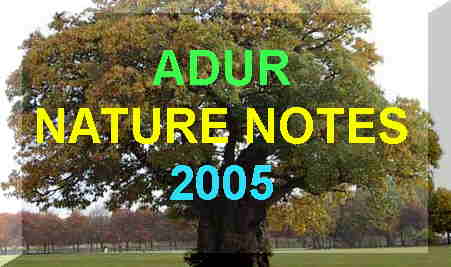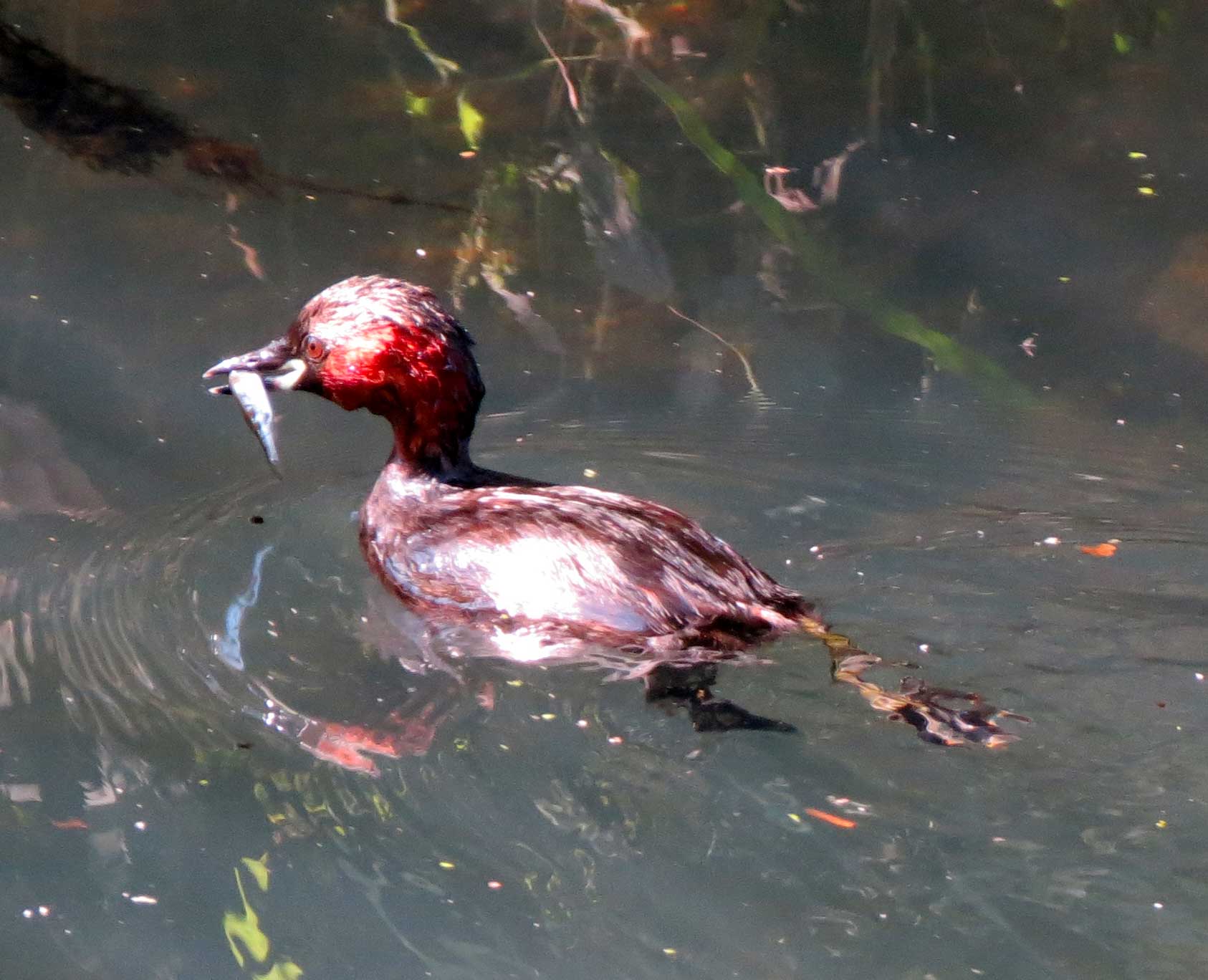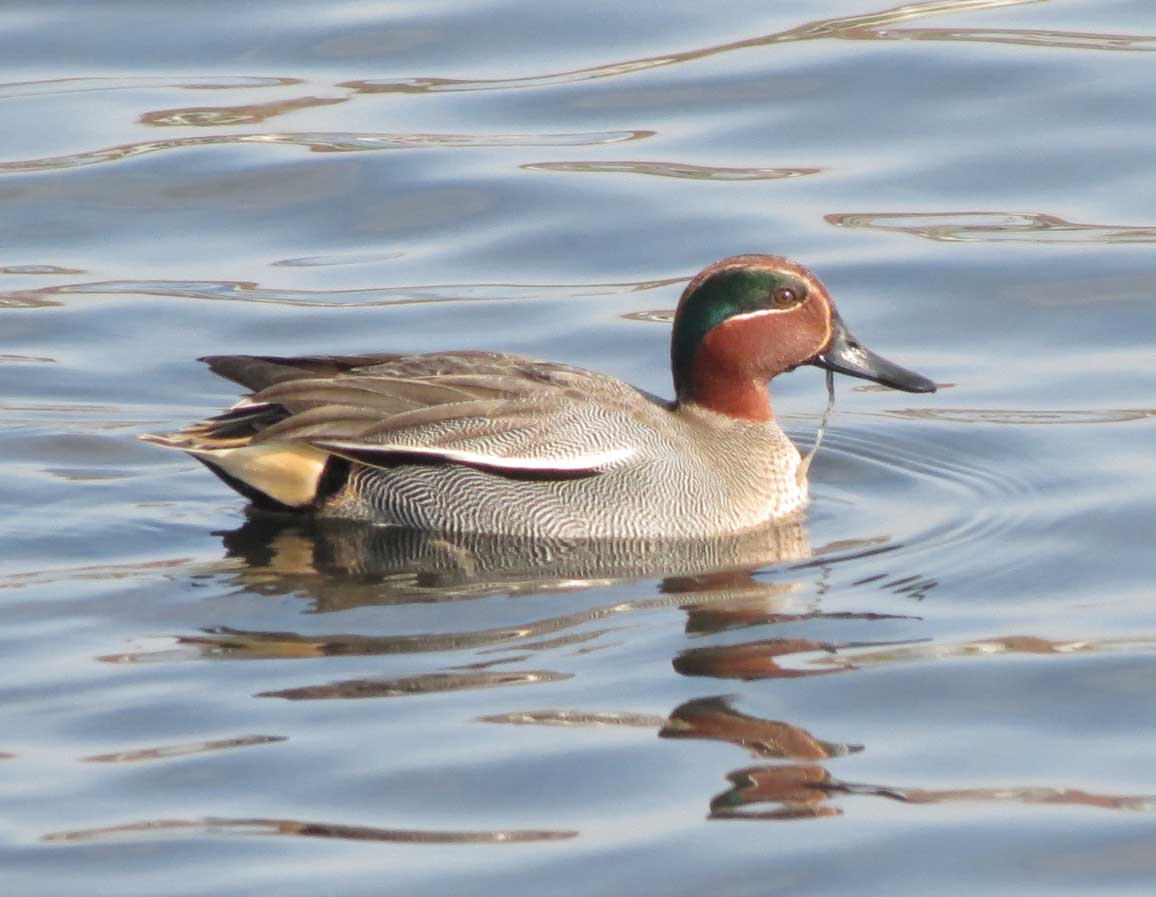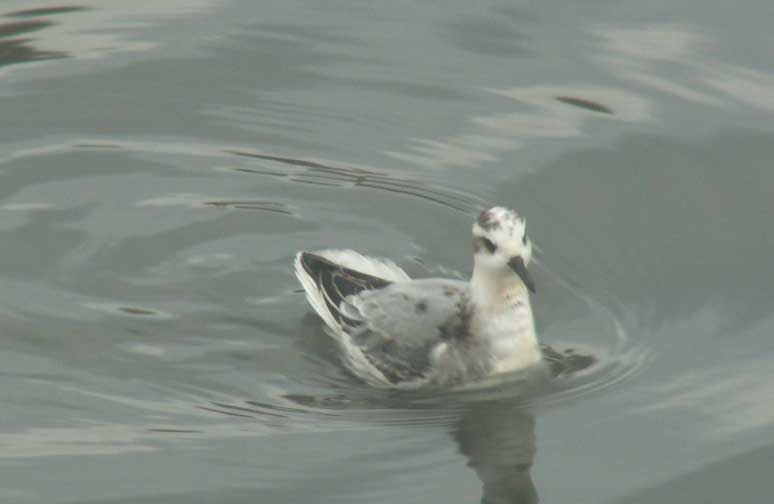 |
|||||||||
|
|
|||||||||
 |
|||||||||
 |
|||||||||
|
|
|||||||||
|
|
|
Brooklands
Boating Lake
formerly
the Brooks
 |
 |
10 August 2021
Occasional Comma Butterflies
appeared by the Teville Stream, Brooklands,
along with a fresh Speckled
Wood, occasional Small
Whites, and three
Southern
Hawkers
(dragonfly).
Large Carp
were making ripples in the shallow water by the bridge,
The miniature weed the Stork's-bill,
Erodium
cicutarium was recorded. I also noted
the more impressive Purple Loosestrife
in
the waterside margins of the main pond.
2020
19 October 2020
There were over a dozen very large muddy coloured Carp in the Teville Stream.18 October 2020
A Bearded Tit visited Brooklands.
2019
29 May 2019
23 May 2019
A diesel spill in Lancing Business Park drained into Brooklands Lake poisoned the water and resulted in dead fish floating on the surface..Mute Swans and four Cygnets
BrooklandsThe adult Mute Swans hissed at dogs and actively chased off a pair of Mallards.
2018
25 October 2018
The tracks of the miniature railway were removed.11 May 2018
As part of the renovation, the vegetation has been removed from the islands in Brooklands Lagoon. The miniature railway tracks were overgrown.
20 March 2018
2 February 2018
An Avocet is spotted on the exposed waterlogged mud of Brooklands Boating Lake. The Avocet is a rare visitor to the lower Adur Valley and local shores.
(SOS: Scarce winter visitor and passage migrant; scarce and localised breeder.in Sussex)
Fencing around Brooklands Lake made it a rather unattractive place to visit, although the diggers for the remedial work were not active. Freshwater from the Teville Stream ran rapidly over the small weir and into the lake. The rippled water hosted a Moorhen and a Coot.
2017
21 February 2017
The authorities have decided to drain Brooklands main lake leaving lots of exposed blackish mud with small rivulets. Commotion in the very shallow rivulets was when the large Carp and smaller silvery fish disturbed the surface. The Little Egret threatens to have a bonanza with the small fish, but the large carp, mostly a dark grey in colour, seem too large even for Cormorants and Grey Herons to swallow (neither were present) .Coots and Moorhens waded in the mud and swam on a few shallow pools in the boating lake. A pair of Little Grebes dived under the Teville Stream above the small weir. This stream was murky and nothing could be seen beneath its surface. A small flow of water trickled over the weir into the main muddy lake.
20144 August 2014
A shoal of over a hundred Rudd was impressive as they swam in the slightly murky water of the Teville Stream flowing into Brooklands Boating Lake. A submerged Little Grebe then scattered the shoal but the Rudd were too large for this small red-headed diver in summer plumage, and it emerged with a small silvery fish in its beak. In the shallows I spotted some minnow-like fish fry and then a much larger Carp-like fish cruised by. A Coot played with a reed and a Moorhen squawked in the streamside plants.
10 March 2014
One of a pair of Teals on Brooklands Boating Lake
with Moorhens, Coots and Mallards numerous on the lagoon
16 August 2013
A Mute Swan was discovered seriously ill on Brooklands Boating Lake and struggling to stay afloat. It was rescued by Wadars and put in the Animal Ambulance. The Environmental Agency have confirmed the existence of blue-green alga (cyanobacteria) which produces toxins capable of causing the illness.
9 September 2011
Coot Moorhen 8 September 2008
7 April 2008
A pair of Tufted Ducks swam on Brooklands Boating Lake, with a few of the usual Mallards and Coots seen in passing.12 January 2006
A local birdwatcher reported a Ruddy Duck, Oxyura jamaicensis, from near the island on Brooklands Boating Lake but when I arrived I could not discover the bird in the fading light. This bird can be recognised by its tail which is often seen sticking up like that of a wren when it is on the water.
16 November 2005
A hundred plus ducks and other bird congregated* at the southern end of Brooklands and this almost certainly frightened the Grey Phalarope away. There were the usual scores of Moorhens and Coots, frequent Mallards and a handful of Mute Swans, Pochards and Little Grebes on and beneath the water. On land, there were the occasional Pied Wagtails, one Dunnockseen and scores of Black-headed Gulls with the occasional possibly frequent Herring Gulls. (*This was probably because they were being fed.)13 November 2005
A Grey Phalarope, Phalaropus fulicarius, swam around on the surface near the southern sluice gates of Brooklands Boating Lake. It appeared to be feeding on microscopic organisms near the surface of the water at one every second. Occasionally (once every five minutes) it made a short flight lasting about five seconds to another part of the lake all within easy view of the handful of birdwatchers.
This wading bird was a quite active and although it seemed unwary and unperturbed in the vicinity of people, it was constantly on the move and it was not straightforward to get a clear photograph in the poor light on an overcast day. After about fifteen minutes it stopped feeding and began to preen.
Picture Page
Better Images on Birds of SussexAt the northern end of the freshwater reaches (Teville Stream) I was pleased to get a glimpse of the exquisite turquoise of a Kingfisher flying up into an evergreen tree. Rarely, does the colourful plumage get revealed quite so clearly as this, if only for a second.
12 November 2005
Two Grey Phalaropes were seen and photographed together on Brooklands. One was assumed to be the same one seen before on Widewater.7 - 15 November 2005
A Grey Phalarope, Phalaropus fulicarius, visited Brooklands Boating Lake, east Worthing (on the Lancing border) and this wading bird was showing very well. It was in its white and grey winter plumage.
The Grey Phalarope winters at sea over the eastern coastal North Atlantic Ocean.
The Sussex Ornithological Society classifies this bird as a very scarce or rare autumn or winter visitor. It is usually found on the coast after a series of gales.
Reports of the The Grey Phalarope in the Adur lower valley area are very scarce, numbering about one a year and absent in some years. It is the first report on the Adur Nature Notes although they have been seen before since 2000.
Sussex Ornithological Society Records
Adur Weather 2005
20 May 2005
20 October 2005 A Migrant Hawker (dragonfly) patrolled the freshwater reaches above the weir, where two adult Mute Swans and four almost fully grown cygnets were feeding on or amongst the rushes.
The Moorhens was on her nest north of the weir, looking after her multiple (at least four) chicks whilst her partner brought her reeds which she arranged on the nest, and I noticed a yellow tip to her red beak.
The Mallard had eight ducklings. One was wayward and got separated from his kin.25 April 2005
At least one hundred aerobatic Swallows swooped low over Brooklands Boating Lake, with their navy blue feathers and forked tails, making an attractive display. Coots were on their nests (at least two) and a Mallard led its family of ducklings.
20 April 2005
There were four Tufted Ducks and a Pochard on Brooklands Boating Lake. There were also the gulls which I could not decide if they were dark-backed Herring Gulls or Lesser Black-backed Gulls or another one of the same group of gulls. Because they were sitting on the water, the colour of their legs could not be discerned.9 April 2005
The Great Spotted Cuckoo is last seen flying strongly north from Brooklands.Report on Sussex Rare Birds8 April 2005
With the cold wind chill (about 6 ºC) and an air temperature only reaching a maximum of 9.1 ºC, the Great Spotted Cuckoo could have hardly felt at home. It was hiding in the trees on the island in the middle of Brooklands Boating Lake above with what may have been a Moorhen'snest, and thwarting the attempts of over a dozen birdwatchers to get more than a glimpse of the bird. When the cuckoo turned I managed a glimpse of its white rump that lasted less than a second.
A Coot seemed to have built a nest on the water right next to the island.
6 April 2005
Conspicuously trotting over the short mown golf course green at Brooklands (east Worthing) the Great Spotted Cuckoo, Clamator glandarius, seemed unaware of its audience of birdwatchers. Under an overcast sky with a Strong Breeze (Force 6) blowing off the sea from the south-east, the cuckoo could be seen clearly out in the open where it seemed to be pecking at the ground (more like a Pied Wagtail than a Starling) for food.
Image GalleryThe Great Spotted Cuckoo spends the winter in Africa and flies north to southern Europe (including Turkey and Spain) to find a bird's (usually a corvid's, especially Magpies') nest to lay a single clandestine egg for the surrogate parent bird to incubate and feed. It is a rare vagrant to southern England with only 39 records in Britain and Ireland up to the end of 1995. One of those was near Shoreham Airport before in 1990.
Birds of Sussex
Great Spotted Cuckoo Photograph
Map Link (The Cuckoo was on the map where the letter 's' is in Golf Course).There were a couple of pristine "Scandinavian" Lesser Black-backed Gulls on the grass (formerly the pitch 'n putt course) immediately to the west of the lake (but not the golf course where the Great Spotted Cuckoo was). The legs of this gull were a very bright yellow.There was plenty of varied bird song and the other terrestrial birds noticed included Blue Tits, Chaffinches (not Bramblings), Blackbirds, Song Thrushes, Starlings and others unseen.
23 March 2005
There was just one Pochard seen amongst the usual Mallards and Coots.
9 February 2005
The twenty or so Pochards were tucking their beaks into their body. There were as many and probably more Coots on the lake, plus the occasional Moorhen.12 January 2005
There were two Dunnocks amongst the reeds at the edge of the lake and Pochards amongst the Coots and gulls.
13 December 2004
Four Tufted Duck are seen on Brooklands Boating Lake with twenty Pochards. Tufted Ducks are carnivorous, feeding on insects and small invertebrates, whereas Pochards are vegetarian.Report by Paul James on Sussex Ornithological Society News
1 December 2004
On Brooklands Boating Lake there were half a dozen or so Pochards, and at the southern end there was a congregation of about thirty Coots and a dozen or so Moorhens. It was here that I spotted a colourful yellow Grey Wagtail on the sluice gates.29 October 2004
I visited Brooklands Lagoon, Worthing this afternoon. I was busy watching a winter passage Little Gull, when five more tumbled out of the sky settled on the lake and started to actively feed. They were all adults. Also Firecrest, Kingfisher and Grey Wagtail.Report by Bernie Forbes on Sussex Ornithological Society News
8 October 2004
A few of the more interesting birds had been reported from Brooklands recently, but I expect this from from the early risers, as in the mid-afternoon, there were just 30+ of the usual Coots or a fully flooded lake and a few Moorhens.28 July 2004
The first Emperor Dragonfly of 2004 was spotted majestically flying up and the down the Teville Stream that feeds into Brooklands Boating Lake over the reed-bordered stream open to the public. It had a a very bright pale blue abdomen and looked fresh in the sunshine.The boating lake was noted for the return of the commoner birds with about 30 Coots and a handful of Moorhens as well. At the southern end in a shallow area near the weir, small shoals of Ten-spined Sticklebacks and freshwater water beetles including the Water Boatmen were noted. A Common Darter Dragonfly flew over the lake.
Adur Damselflies and Dragonflies30 June 2004
Booklands Boating Lake in flood but there was a paucity of birds, just a pair of Mallards were seen in the main area of the lake.16 June 2004
Below the weir the main part of Brooklands boating lake looked slightly a milky white colour. I did not see any of the usual Moorhens and Coots and there were just a handful of gulls on the surface of the water in the centre, which did not seem to be discoloured.27 May 2004
The Moorhen chicks followed the white bread that was fed them accompanied by a Coot and no sign of the parent Moorhens although a Mallard was also at the feeding station on the main part of the lake but just south of the weir and bridge, by the miniature railway station.
(People are discouraged from feeding the water birds by notices.)
Brooklands Wildlife News Reports 2004
Script
and page design by © Andy
Horton 2005
Local Wildlife Links (SE England)Adur Biodiversity Exhibition 2001
Adur & the Downs: Protected Sites
Adur Valley Nature Notes 2003
Adur Valley Nature Notes 2004
Adur Valley Wildlife
Adur Wildlife Gallery
Birds of Sea & Seashore (BMLSS)
Carmarthen Bay Saltmarsh SAC
Dungeness, Kent, England
Friends of Widewater Lagoon
Orford Ness: Coastal Ecology of a Shingle Bank (excellent references)
Ralph Hollins Nature Pages (Chichester Harbour area)
Rockpooling Page
RSPB Saline Lagoons
Rye Harbour Nature Reserve
Seashore Page
Shingle Coast (Coastal Fringe of Shoreham Beach)Shoreham-by-Sea Wildlife Page
Sussex Wildlife Web Sites
Verdant Mud (Glasswort)
Widewater Lagoon Slide Show (by Ray Hamblett)
|
|
|
|
|
|
























